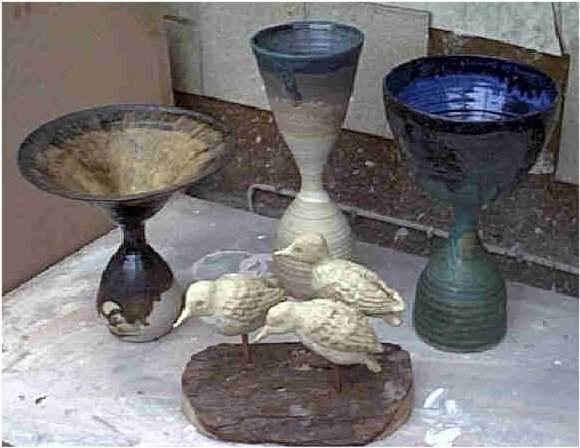

1. There are three, basic, types of clay. These are Earthenware (usually red), Porcelain (usually white) and stoneware (usually grey/buff). Specialist clays that are pre-coloured are also available usually using an earthenware body (clay). Earthenware is also the natural clay from the ground, stoneware and porcelain are both man made mixes of natural clays.
2. Stoneware clay is cleaner, more versatile and able to take both earthenware and stoneware glazes and slips. Both clays are pre-fired (biscuited) at 900 c. The body turns from clay into pot at about 500 c. it can no longer be soaked down in water and back into clay after this. Glaze or glost firing temperatures for the second firing of glaze onto pottery varies from 1010 c. - 1030 c. for earthenware, to 1220 c. - 1300 c. stoneware/porcelain. At these temperatures the stoneware clay is fully vitrified and non porous even without glaze, but earthenware is always porous, unless glazed.
3. Decoration for pottery comes under the following headings -:
a. Applied decoration - clay shapes
added to the surface of pottery.
b. Incised decoration - decoration
cut into the surface of pottery.
c. Slips - these are divided into
three categories.
1. Coloured slip - usually earthenware clay mixed with colouring pigments or oxides and water to a cream and applied to wet or leather hard pottery. It can also be applied to stoneware clay but must be fired to earthenware temperatures in this case. Usually slips are given a clear glaze but a transparent honey glaze can be very effective. Ideal for younger students and a limited budget.
2. Casting slip - a specialist slip used in casting pottery from a plaster mould. The slip is made from powdered clay, sodium silicate and water. The sodium silicate allows a minimal use of water to make the mixture liquid, thus allowing continuous castings to be produced without saturating the moulds.
3. Slip or Slurry - liquid clay of the same body as the clay in use to act as a glue.
4. Glaze
Under Glazing is achieved by painting
oxides or special colours onto bisc. Pottery and then coating
in clear glaze, nearly always earthenware.
Onglaze enamels are painted onto
already fired pottery and then re - onto the surface, as are metallic
lustres.
Onglaze or overglaze colours are
oxides or colours painted onto the surface of the unfired glaze.
E.g. Majolica, (blue , cobalt oxide onto a white, tin glaze).
Coloured glazes. Think of glazes
as powdered glass which will be melted over the surface of your
pottery. This mixture can have additions of special colouring
materials usually made from oxides e.g. iron oxide = brown, cobalt
oxide = blue, manganese oxide = black, copper oxide = green. Stoneware
glazes are usually matt and can only be used on stoneware clay,
earthenware can be used on both clays. As a rule bright colours
and stains or painting powders are only in earthenware. Remember
that ceramic colours are totally different from ordinary paints,
ordinary paint colours would simply burn away in a firing.
5. Wet clay must be joined by slip, not just water. You can join wet to wet , or wet to damp but once the clay is dry it cannot be joined. Keep pots that are being worked upon in an airtight container or plastic bag.
6. Unless you are placing stilts (a small ceramic tripod) underneath the pot do not glaze the underneath, leave a border at the base of the pot of at least ¼ inch clear of glaze in case it trickles. Pots that are able to stick to a shelf will be ruined, will damage other pots and destroy a kiln shelf worth up to £30.00.
7. Other dangers !!!
Do not trap air in a hollow pot,
make small holes in it wherever air is contained. Make sure that
you have wedged or kneaded your clay well in order to remove trapped
air bubbles before producing a pot. Do not build pots of over
½ inch thick , unless you are using a clay especially prepared
for this e.g. grogged or with crank. (crank is pre-fired pottery
ground to a sand and added to the body to give it stiffness, less
contraction and a faster drying rate, good for large sculptures).
Do not allow impurities to enter the clay e.g. stones, plaster
etc. they will blow up in the kiln. You may stuff pots with paper
to give internal support as this will burn out later but consider
the smell of burning, for a brief time it will fume, ignite and
smoke
Make sure that your technician, teacher
or kiln owner is aware of your plans to avoid a fire alarm !
8. Cleaning. All ceramic materials should wash out, use sponges to wash hands and equipment.
9. If wet clay is on clothing don't try to wash it out, let it dry and then brush it off as a dust. Never use glass containers near to clay or glazes. An accident that occurs near to clay or glazes that possibly leaves splinters or pieces of glass hidden in these items would be fatal and would mean the disposal of the stock.
Send for further lessons...
